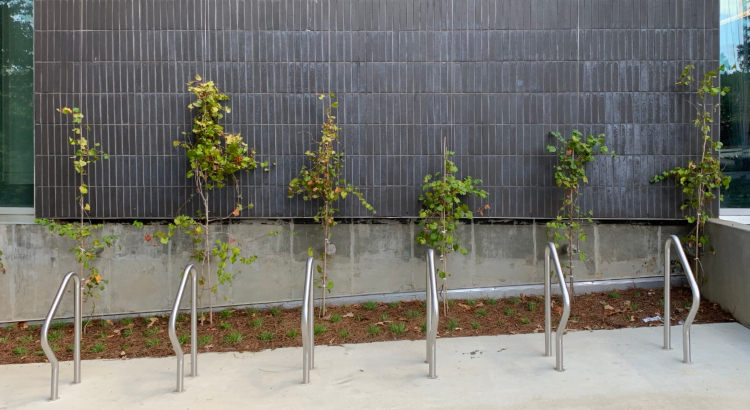Fresh off its October dedication, the Kendeda Building continued to get attention from media outlets and corporate websites over the last month. It was aided by the fact that Greenbuild came to Atlanta in late November.
Here’s a roundup on what they’re saying. (For a similar look at more than a dozen earlier articles and videos that appeared closer to the building’s opening in October, click here.)
Leed is for wimps; the Living Building Challenge really pushes the building envelope. The Greenbuild conference is built around the LEED certification developed by the US Green Building Council, but LEED is for wimps compared to the Living Building Challenge (LBC). A tour of Kendeda Building on Georgia Institute of Technology campus is a great example of the standard’s ambitions and contradictions. It’s also a really lovely building designed by Lord Aeck Sargent and the Miller Hull Partnership, the same firm that designed the other great demonstration of the LBC, the Bullitt Center in Seattle. — Lloyd Alter, The Kendeda Building is “the greenest in the Southeast,” Treehugger, Nov. 25.
We’ve got this technology that takes carbon dioxide out of the atmosphere and creates building material, and that technology is called a tree.
One thing I’m really, really fascinated by is the state of Georgia to use its agricultural industry to create building product. So think about it: We’ve got this technology that takes carbon dioxide out of the atmosphere and creates building material, and that technology is called a tree. And Georgia’s the number one state in the country for timber products. So why aren’t we creating high-tech timber products [like those] we have in the Kendeda Building that replace the need fo importing steel? Why aren’t we looking at our agricultural waste product and thinking what can we do with agricultural waste and turn that into a building material. And so I think what the Kendeda Building shows here in Georgia is Georgia solutions —homegrown Georgia solutions — that cut though some of this political discourse, because at the end of the day, I think Georgians fundamentally care about the environment and Georgians fundamentally care about the economic future of this state. And with green building, we have the opportunity to really bing both of those absolutely in sync. — Kendeda Building Director Shan Arora on On Second Thought, Georgia Public Broadcasting, Nov. 25.
There are a number of important takeaways from this and other Living Building Challenge projects. We’ve learned to remain open and embrace the creative building process because big idea projects such as this are unique and no two buildings are alike. Not every project can hope to generate zero waste and produce more energy than it uses, but finding ways to implement some of these strategies can go a long way toward making every new or renovated building more energy efficient, environmentally responsible, and resilient. — Skanska USA Executive Vice President Scott Cannon, One Project’s Road Map to Developing a Living Building, GlobeSt.com, Nov. 15.
A combination of natural wood and cement with broad, large windows, the building seems like it should be in the middle of the woods instead of on a college campus in Atlanta.
Skanska is currently pioneering some of the most sustainable projects in the world, including the Kendeda Building for Innovative Sustainable Design, a project on the Georgia Institute of Technology’s Atlanta campus that is pursuing Living Building Challenge certification. … The building includes a salvaged item for every 500 square metres of building and is projected to generate at least 105 per cent of the energy that it uses. — Sue Weekes, Green building tool provides insight on smarter practices, Smarter Cities World, Nov. 22.
Now that the Kendeda Building for Innovative and Sustainable Design is open to students and the public, the most difficult phase of achieving Living Building certification has begun. Unlike other green building standards, the Living Building Challenge requires 12 months of proven performance before a certification is achieved. This means modeling for net positive energy and water isn’t enough – you must walk the walk too. Several Living Buildings have taken more than 12 months to achieve this, often troubleshooting along the way. Sometimes a particularly warm summer or dry stretch of weather may cause the clock to reset. — A Living Building in the Southeast – The Kendeda Building at Georgia Tech, Prosoco corporate blog, Nov. 17.
From the outside, the building feels almost out of place for its urban surroundings. A combination of natural wood and cement with broad, large windows, the building seems like it should be in the middle of the woods instead of on a college campus in Atlanta. But that’s part of the design. Using reclaimed wood, windows that help regulate the temperature, and a sophisticated water reclamation system, the building is designed to barely make a blip on the ecological radar. — T.J. Muehleman in Atlas Obscura.
PHOTO AT TOP: Mulberry plants will provide foraging fruit to help meet the Kendeda Building’s Urban Agriculture Imperative, while bike racks contribute to the Human Scaled Living Imperative. Photo by Ken Edelstein.


